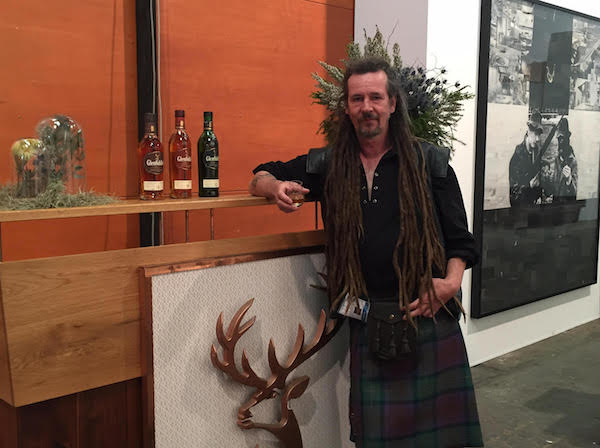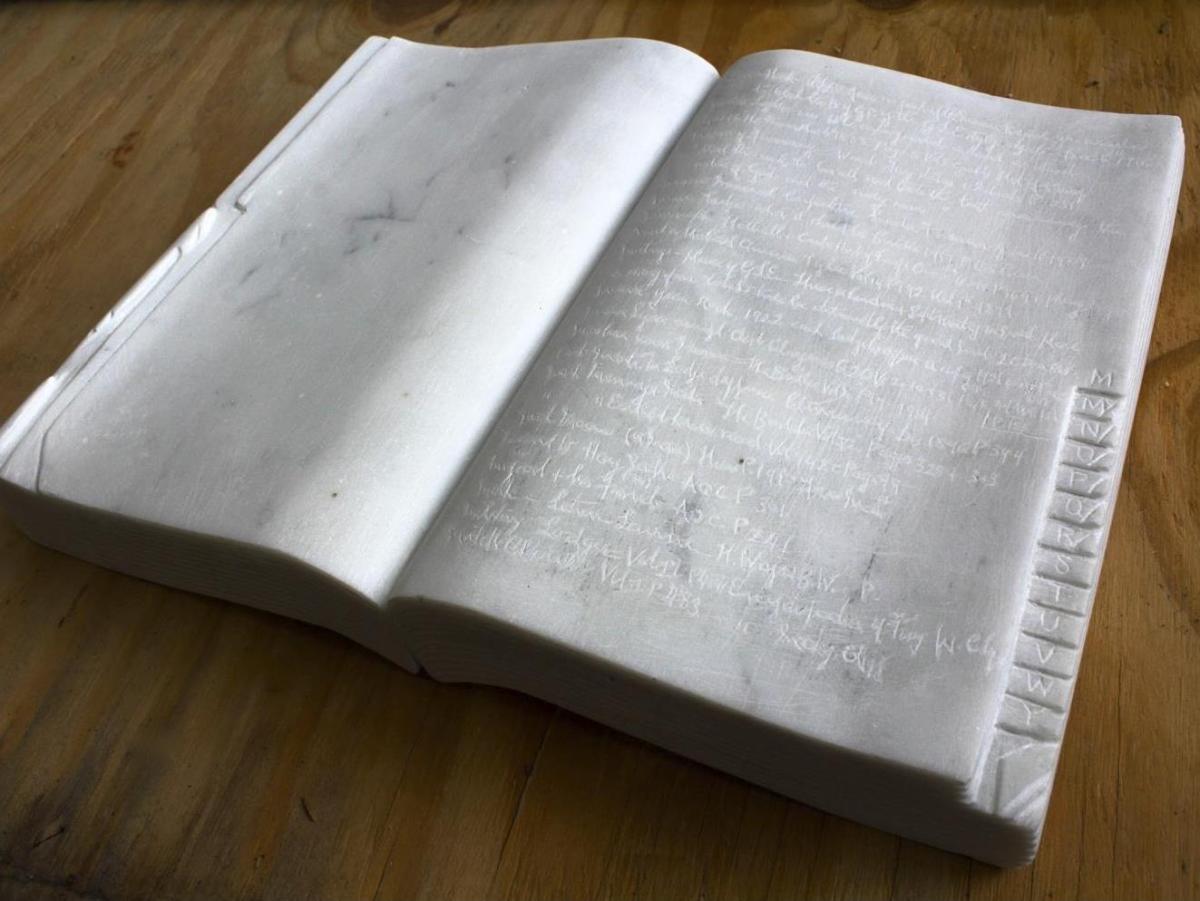Artwork by winning artist Elyse De Valle; supplied courtesy the artist
The cliché is that at art fairs you usually find sparkling wine and Semillon drinkers. But during the recent Sydney Contemporary art fair, there was a stand that stood out for its maverick spirit. Returning for the third time, Glenfiddich Distillery with its pop-up whisky bar headed up by Artist in Residence Program Curator, Andy Fairgrieve, was promoting its own suite of artists.
Fairgrieve told ArtsHub: ‘Obviously at a fair you have different galleries all showing their artists; in a sense we are also promoting “our” artists.’
It was not the usual crowd one might expect to find a dreadlocked, kilt-wearing Scotsman in, but then Glenfiddich is all about seeking out creativity, whether it be discovering a new blend or a new artist.
Fairgrieve is in Sydney to select this year’s winner for the 2017 Glenfiddich Artists in Residence Prize, which was announced this week. Melbourne artists Elyse de Valle was selected.
Faigrieve said: ‘With such a strong showing of talent in our five finalists, the winning choice was no easy matter. Of course we can only select one artist but in the end, it was the craft and skill of Elyse’s talent that won the day. I am sure her practice is one that will be fully appreciated by the skilled crafts persons who work at Glenfiddich and for her part I know the exposure to the historic architecture of Scotland will feed and inspire her residency.’
de Valle said on hearing of her win: ‘Memory and narrative play a key role in my work and I hope to share some great stories and shared experiences during my time there, maybe even over a whisky or two. This, along with the extensive archives kept by Glenfiddich, will lead me along interesting paths for my work. I cannot thank the William Grant & Sons Group and the Glenfiddich Distillery enough for this opportunity.’

Artwork by winning artist, Elyse de Valle; supplied courtesy the artist
The finalists were: Belem Lett, Elyse De Valle, Hiromi Tango and Craig Walsh, Lillian O’Neil and Penelope Cain. They were drawn from an open call and chosen by a high profile panel including Barry Keldoulis (Group Fairs Director), Evan Williams (CEO of Williams Land Trust), Dr. Gene Sherman (Chairman and Executive Director of the Sherman Contemporary Arts Foundation), Mark Hughes (art advisor) and actress Rachel Griffiths.
Fairgrieve said: ‘We let the jury do their own thing – the decisions they make are their decisions, and that is important to give the Prize authority. But personality is another consideration. One of the main reasons I come over is to meet the shortlisted artists and make a decision from there.
‘You want people who are able to mix. The Australian section of the residency program is not in isolation. They will be with seven, eight other artists from around the world, all at the distillery at the same time, so to have a balance is important.’
Fairgrieve said that while he is still coming to grips with the five finalists’ works, his first impression was the powerful work of Penelope Cain. He was quick to add, however, that that could all change.
‘It is about getting a feel for the work over the days of the fair, and meeting the artists and finding out what their concerns are in their art.’
He continued: ‘That private side to the artist has to be considered as well. I am trying to find the balance in who they are as well as what is on the wall. That is the evolution in the process of making that decision.’
Introducing the 2017 Glenfiddich Artists Residency Winner
Fairgrieve said that artists should be able to confidently present their view. ‘I can see there is this interest in landscape across the finalists – it may have been conscious of the jury to push it in that direction’, he noted, adding that whisky is a product of its landscape.
‘Anyone can do something that is nice and safe, but an artist who can tap into social concerns or geopolitical interests, I think is doing something important. Art through the ages has tapped into that zeitgeist, and those are the initial hooks that I am looking for.’
Fairgrieve told ArtsHub: ‘It is good to sometimes confuse people with your choices.’ Clearly, the Scotsman takes the task very seriously.
A Melbourne born and based artist, De Valle is an emerging artist who utilises materials and sites to express the conceptual concerns of her practice. De Valle’s work explores little known narratives that permit her contemplation of creative labour, memories, loss and experience. It is often a pursuit to trace and respond to social history, reflecting on how memory is encoded directly and indirectly within the built form.
She is hoping to have the opportunity to consider the question: “Can the work of contemporary artists help us re-imagine the ways that we learn from history and imagine the past?” To do so, she plans to dig deep into the Glenfiddich archives and engage the Dufftown community.
Fairgrieve’s advise to the de Valle was that time is your enemy.
‘Three months at the outset feels like a very long time and then it flashes past; you need to be quite disciplined. Art doesn’t work by saying “I am going to start here and end up there”. The detours are what take time, so you need to be efficient and factor in that you may be distracted,’ he said.

Glenfiddich Artist in Residence Program Curator, Andy Fairgrieve; Photo Artshub
The contending finalists
Penelope Cain is interested in ‘landscape’ in its widest term, enveloping social, historical and spatial narratives, and the marks of economic issues such as globalisation and trade on the land. She is interested in the Glenfiddich property, and wider Speyside, as she is drawn to the points of porosity: between natural and industrial, town, factory and field, historic, established and emerging industry, global and local.
Belem Lett’s painting practice straddles figuration and abstraction, as he is interested in imperfect symmetry. If chosen, he plans to make a Scottish Rococo work, which is emblematic of the locality in which it is made and drawing upon the local landscape and the visual history of family crests and heraldry present within Scottish Culture.
Lillian O’Neil creates large-scale pictorial compositions or collages that are informed by the tradition of the image-atlas or Mnemosyne Atlas (Aby Warberg). She also hopes to dig into the Glenfiddich archive to create a new series of collages if awarded. This project would continue her commitment to the materially of obsolete print technologies as well as to cultural histories depicted in found photographs.
Hiromi Tango and Craig Walsh would not be the first collaborative team to head to Scotland if chosen. Their practices bring together site-responsive projection works with a unique mix of textile sculpture, performance and community engagement. During their residency, they plan to engage with the distillery, its history, and the people of the community, and also look toward the future of the distillery.
The Glenfiddich Artists in Residence Prize is celebrating its 16th year globally. The winning Australian artist will be awarded a unique residency prize valued at $21,000, and will work and live for a period of three months in 2018 at the Glenfiddich Distillery in Dufftown, Scotland. They even have the bonus of mentoring from Fairgrieve.
Past Australian winners have included Joan Ross (2015) and Stanislava Pinchuk (aka M-I-S-O) (2016).





